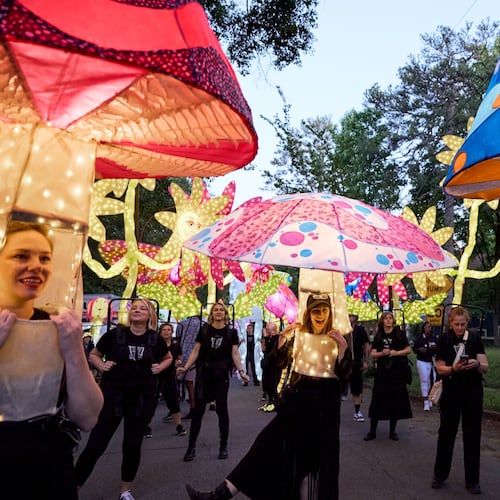It was an unusual scene for the quiet road behind the High Museum of Art on Thursday: workers posing for giddy snapshots, onlookers gathering, a crane ready to work, yellow caution tape to keep the excitement under control.
“What more could a curator ask for?” Gary Radke said, watching as a crane lifted a massive piece of Leonardo da Vinci-designed artwork into the sky. He followed with his eyes, then ran up stairs to see it swing over a 70-foot wall, taking the white-gloved work of exhibition installation to terrifying heights.
As the piece inched toward the ground, Radke turned his head.
“Every once in a while, there are moments when I look away,” said Radke, consulting curator of Italian art at the High and the Dean’s Professor of the Humanities at Syracuse University. “Emotionally, it’s just difficult for the curator.”
Nobody expected to have da Vinci’s 24-foot Sforza horse in Atlanta for the “Leonardo da Vinci: Hand of the Genius” exhibition, which opens Oct. 6. Not so long ago, nobody ever expected to see the work at all.
In the late 1400s, da Vinci envisioned the world’s largest, most technically challenging statue, one that would depict Francesco Sforza, Duke of Milan, on horseback.
Over nearly two decades, from 1482 to at least 1499, Leonardo developed painstaking plans for the sculpture and techniques to build it. He got so far as to create a huge clay model, intending to create a bronze cast that would remain on display in Milan. But war with France was imminent and bronze for the horse was requisitioned for cannons. Invading soldiers destroyed the great clay horse, the one da Vinci expected to be a defining work.
Perhaps what defined him more, though, was what he left behind: plans. The High exhibition features more than 50 works, including sketches and studies by the prolific artist-inventor-sculptor-scientist-philosopher-architect, who died in 1519.
Although da Vinci never cast the horse, his elaborate plans are some of the best documented in art history, da Vinci scholar Andrea Bernardoni wrote, “illustrating Leonardo’s exemplary way of confronting a project of unprecedented complexity.”
The Sforza horse reveals da Vinci’s artistry, but other materials in the exhibit showcase his engineering — the cog-and-pulley system he created to build the oversized horse, the positioning for furnaces to melt and deliver the bronze to the mold.
Those plans and sketches were used to re-create da Vinci’s gran cavallo in the 1980s and finally to make a bronze cast. As Radke and High officials planned the da Vinci exhibition, nobody even suggested moving an enormous bronze statue to Atlanta. But on a trip to an Italian science museum, Radke learned of another plan to remake da Vinci’s horse, this time with six large resin pieces treated to look like bronze but still able to break apart and travel.
Radke shook it off as too complicated, only to hear that the horse would be displayed outside the Tech Museum of Innovation in San Jose, Calif.
“The big horse in front of the museum doesn’t have to be seen as Leonardo’s horse because he never made it,” Bernardoni, the scholar, said when the horse was in California. “It is a reconstruction from his manuscripts to give the idea of the majesty and the impressiveness of his project.”
Radke and High officials traveled to California, stood beside its human-sized hoof and made their decision.
“We saw it, and we knew we had to have it,” Radke said.
The High’s exhibition explores da Vinci’s role in the development of Renaissance sculpture, his influences and his influence on the work of later artists. Though a majority of da Vinci’s sculptures were never realized, the exhibit, including works by Donatello, Rubens, Verrocchio and Rustici, conveys his central role in sculpture’s development.
The horse embodied the narrative of da Vinci’s life, but also his keen sense of how to mix science, art and dreams.
“We wanted people to get a sense of how ambitious this was,” Radke said. “It’s taking us a week to put this thing together with modern technology and a professional crew.”
Even in pieces, the horse was too big, too special to maneuver up stairs and through doorways. Their only option was to use a crane to lift it over a wall so it could be assembled in the piazza.
“You can imagine the reaction of the museum in Florence when we said we were going to swing it over the side of the museum,” Radke said.
Skeptical, cautious, but after seeing the plan for themselves, not unwilling.
By August, pieces of the horse had arrived in Savannah on a ship. UPS moved them on land. By midday Thursday, the horse stood tall in Atlanta.
And when the exhibition comes down in February, the horse will leave exactly the way it came — by leaping back over the wall, with the help of work crews, a crane and a plan.
About the Author
Keep Reading
The Latest
Featured

